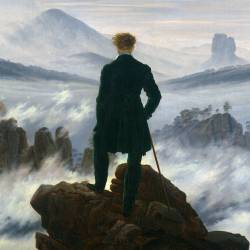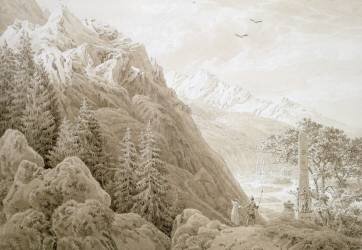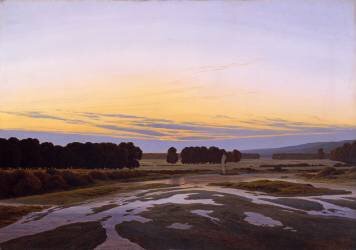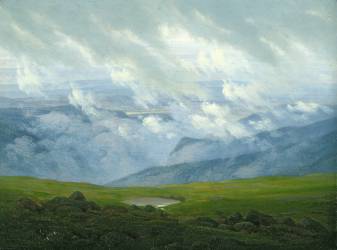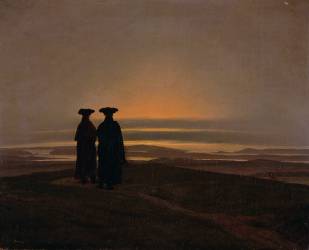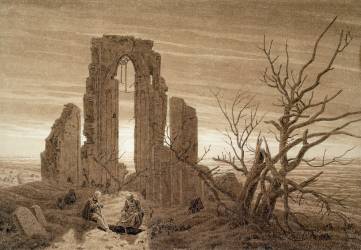Artwork of Caspar David Friedrich canvas prints & artprints
A German painter considered to be the undisputed master of landscape painting in the Romantic period, Caspar David Friedrich left his mark on the art world by expressing his emotions through his depictions of nature. From the Louvre Museum in Paris to the Metropolitan Museum of Art in New York, via the Hermitage Museum in St Petersburg and the Alte Nationalgalerie in Berlin, Friedrich conquered Europe and the world with a whole list of paintings in perpetual search of god, but above all of meaning in the human condition.
Check out the list of paintings by the artist who brought thought-provoking details about emotions to landscapes, with the painting "The Traveller Contemplating a Sea of Clouds" (1817, Hamburg Kunsthalle), the work now considered a major page in German Romanticism, the oil on canvas "Man and Woman Contemplating the Moon" (1824, Alte Nationalgalerie, Berlin), a melancholy painting that is also a beacon of hope, or the painting "Le Midi" or that "Le soir" (1821, Niedersächsisches Landesmuseum, Hanover), from the cycle of the hours of the day, whose dark details hint at a portal to the artist's state of mind.
Give yourself a page from the history of art and Romanticism with a painting by Caspar David Friedrich available in the catalogue, and discover his story with his biography.
Biography of Caspar David Friedrich
Training of Caspar David Friedrich
Born in Greifswald, Swedish Pomerania (now in Germany) in 1774, Caspar David Friedrich grew up in a relatively well-off merchant family. Touched by tragedy, he lost his mother, his sister Elisabeth and his brother Johann Christoffer, who perished in the Baltic Sea trying to save him from certain drowning, as well as his other sister Maria, at an early age, in just 10 years, between 1781 and 1791. This page in his life, with its list of tragedies, was to have a profound effect on the young Caspar, whose painting would become tinged with a melancholy that would fill his landscapes.
Early on, he discovered his passion for the arts, and decided to study drawing at the Royal Academy of Fine Arts in Copenhagen in 1794, and did so for four years. During these formative years, Friedrich trained in the techniques of oil on canvas, as well as drawing, pastel and watercolour. This period was marked by the influence of his teachers, in particular Jens Juel, a renowned portraitist, and Nicolai Abraham Abildgaard, a well-known neoclassical painter, who introduced him to history painting, but above all to the landscape style, which Caspar David Friedrich fully embraced. Passionate about the representation of nature and all its details, he nevertheless did not forget to refine his technique in other styles, particularly in portraiture, as evidenced by his painting "Study of a Seated Young Man" (1798, National Gallery, Prague), bringing great versatility to his drawing.
The early years: nature at the heart of Caspar David Friedrich's work
Following his studies in Denmark, Caspar David Friedrich travelled to Dresden, the city in which he established his studio in 1798. A place where the Romantic movement was in full bloom, notably with the presence of important figures such as Goethe and Auguste Schlegel, the young German painter quickly seized on this reflection to incorporate it into his work. Friedrich would also establish links with the latter, maintaining an epistolary relationship with Goethe, and taking a close interest in the work of Schlegel, who supported the idea of a presence of spirituality in nature.
Hence his early works express a strong attachment to nature and an interest in landscapes, in which sky, earth and water intertwine in poetic and spiritual harmony, as can be seen in his oil on canvas "View of the Elbe Valley" (1807, Neue Meister Gallery, Dresden), a landscape whose colours reveal his state of mind at the time the painting was made. The paintings of this period are marked by rigorous compositions, with particular attention to light, detail and colour diversity.
This precise technique earned him an appointment to the Berlin Academy in 1810, and an exhibition in the city, which was then one of the major cultural centres in Europe. The list of commissioners then grew, with renowned buyers such as King Frederick William III of Prussia, making this period of Friedrich's life one of the most prolific of his career.
Maturity for Caspar David Friedrich: symbolism and spirituality
From 1812, Caspar David Friedrich's style evolved significantly to open a new page in his career. While landscape remained his main source of inspiration, he gradually introduced symbolic and mystical elements specific to his spiritual quest. This new aspect permeating his art is clearly visible in works such as his oil on canvas "Cross and Cathedral in the Mountain" (1812, Museum Kunstpalast Düsseldorf) or his painting "Cross in the Forest" (1813, Staatsgalerie Stuttgart).
The spiritual dimension is reinforced by the depiction of figures, often solitary and meditative, who seem to be questioning the meaning of life. Thus, in 1817, one of his most famous paintings saw the light of day, with "The Traveller Contemplating a Sea of Clouds" (1817, Hamburg Kunsthalle), in which the German painter confronts man with his destiny and the unknown, represented by this mist rising from the mountain.
The details of Friedrich's works then become a gateway to the exploration of his own spirituality, particularly in the quest for God, as in "Seaside in the Moonlight" (1818, Musée du Louvre), in which the humanity represented in the foreground enters into a duality with the quasi-divine light represented at the back of the canvas.
A rollercoaster end to Caspar David Friedrich's career
Recognised in Germany, but also in other European countries, and after a period during which he married, and tackled more historical and patriotic subjects, Caspar David Friedrich continued to paint and to interest the aristocracy, particularly the Russian court, with Grand Duke Nicholas commissioning a painting on the theme of Nordic landscapes. Although this has since been lost, it undoubtedly inspired the oil on canvas "The Sea of Ice (1824, Hamburg Kunsthalle)", painted a few years later, and today considered to be one of the painter's major landscapes.
Other famous canvases, in dark shades, show that despite his success, melancholy still accompanied the painter throughout his career. With his cycle of the hours of the day, painted in 1821, comprising four paintings with "Morning", "Noon", "Afternoon" and "Evening", dark colours and fog envelop the subjects, Friedrich's emotions finding an echo in his painting.
In 1824, Caspar David Friedrich fell ill, and his output dwindled. Facing criticism from a section of the art world that considered his approach too symbolic and detached from reality, his work began to suffer public disinterest. Continuing to paint, however, he suffered a stroke that partially paralysed him in 1835. This affected his motor skills and limited his activity. Five years later, Friedrich died in Dresden in 1840, aged 65.
The artistic legacy of Caspar David Friedrich
Recognised today as one of the masters of landscape among the artists taking part in German Romanticism, Caspar David Friedrich was able to create a whole collection of paintings whose details in his depictions of nature, as well as his mastery of oil painting, are still studied in every painting academy.
Although he fell into oblivion shortly after his death, his compositions, synonymous with the romantic cycle of the early 19th century, were to find renewed interest among many 20th-century artists, such as expressionists and realists like Munch and Courbet, but also musicians and writers, such as Samuel Bekett, whose painting "Two Men Contemplating the Moon" (1819, Neue Meister Gallery, Dresden) inspired his play "Waiting for Godot". So today, alongside Goethe or Schubert, Friedrich is an artist who is an integral part of the Romantic aesthetic, and is considered one of the most illustrious representatives of this major theme in the world of the arts.
With their detail and poignantly meaningful theme, canvases such as the painting "The Traveller Contemplating a Sea of Clouds / Der Wanderer über dem Nebelmeer" (1817, Hamburg Kunsthalle), and its man with his back to it, facing the immensity of the mountain, the landscape "The Monk by the Sea / Der Mönch am Meer" (1809, Alte Nationalgalerie, Berlin) or "The Hunter in the Forest / Der Chasseur im Walde" (1814, private collection), are to this day veritable must-haves from this period of early nineteenth-century art, and today take their place in the collections of the greatest museums, from Paris to Berlin, via London or Moscow, as a page from that bygone era and a gateway to this one.


